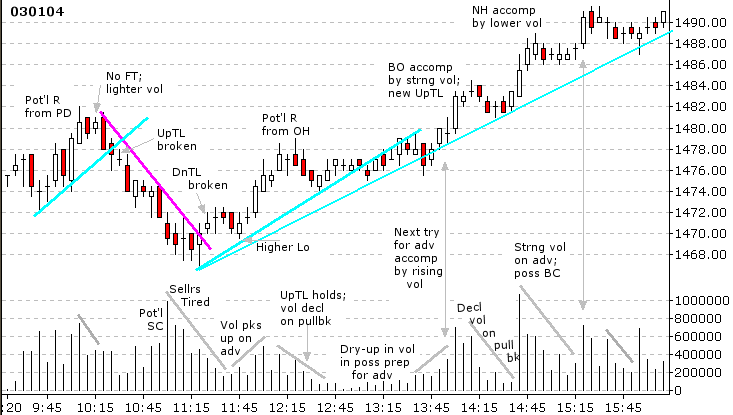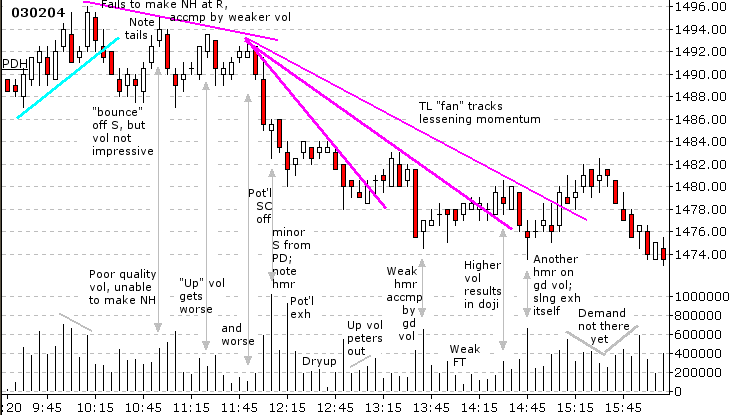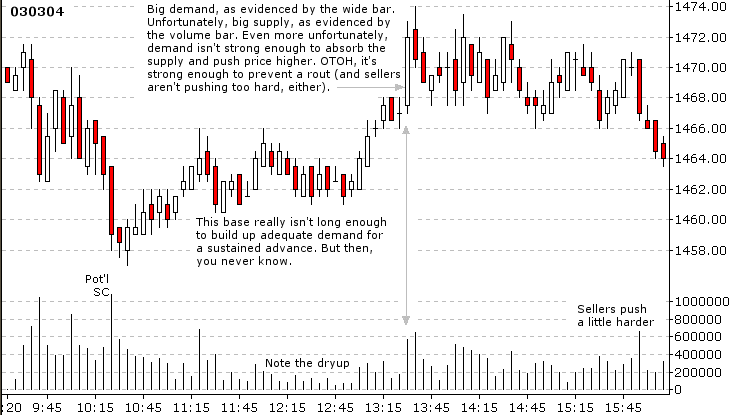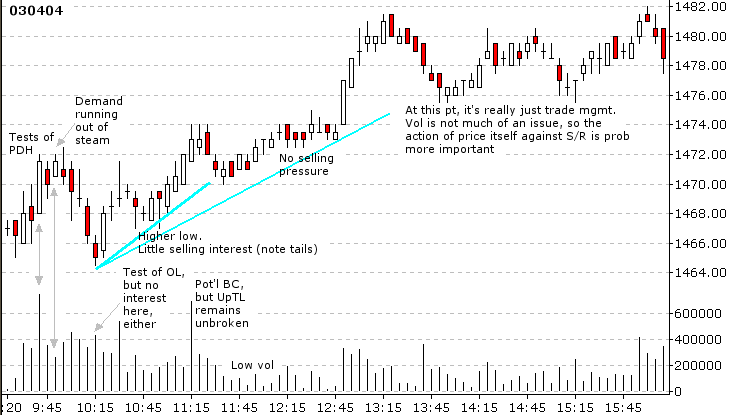Identifying Support and Resistance is fairly straight forward enough to do on all chart timeframes IMHO. The key is the price reaction at those areas. At it's simplest anytime there's a rally the base of the rally can be called Support on the chart, Buyers supported that area by buying. Vice versa for selling. The more times the support/resistance area is retested the more valid your support/resistance is. Please note that I see Support/Resistance as areas and not one price.
I find the harder part to my trading is to know how to trade that support/resistance. There's always the old chestnut of "Buy at Support and Sell at Resistance" but you never really know if it's support until after you've bought and there's also the chance that support won't be fully tested so you're not in a position to buy. Maybe It should read "Buy at or near Old Support and Sell at or near Old Resistance" but I do believe that it's the best place to buy or sell as it gives me natural areas in which to place stops i.e. under said support if buying.
To help get a feel for market direction I look at the price reaction at those support/resistance areas that I've identified. If I see the market go up 70 points in 2 days from the support area and at resistance only goes down 20 points in 3 days. I'd say that demand was present at support but didn't see supply present itself in such a fashion at resistance. Therefore my outlook for that timeframe would be more bullish than bearish. I would feel more comfortable buying at/near support than selling at/near resistance. I also find that timeframes are very important to my trading as what often appears to be a major support area on a daily chart might be nothing more than a correction on a weekly/yearly chart. The longer term support/resistance areas are most important to my trading. e.g. Support on a 5 minute chart is nowhere near as important as on a yearly chart. If support/resistance areas tie up on more than one timeframe then you have a tradable market IMHO. For each timeframe I decide whether I'm Bullish, Neutral or Bearish and it's often the case that I'm Bullish on the weekly chart and Bearish on the daily chart for the same equity.
I personally find that once the resistance area is broken a very profitable area to enter long is at the retest of that old area, hence the adage "Old resistance becomes new support" and vice versa for Resistance.
There's a number of questions that need to be answered when I trade off support/resistance and as with anything the more I trade the better/more confident I get at answering them. I'd also say that my approach is very subjective and I have to make many "Judgement Calls" on what I see around the support/resistance areas. I would love to find a non-subjective system but have yet come across anything which does not require the trader to use his/her judgment when deciding to buy/sell.
I hope this helps,
Dan
For a practical example, I've attached a chart which may help illustrate this S/R business.
There are dozens of swing points in this chart, thousands with a shorter bar interval, but these are enough for the illustration.
Note at 1 that price reverses. You don't know why. Doesn't matter. But it reverses, making a swing point. It's not support. Not yet. Just a reversal due to changes in the balance between buying pressure and selling pressure. At 2, however, this level now becomes support. Ditto for 3 and 4 re resistance.
When this R is penetrated, a new swing point is created at 5, though it's not yet R; it's just a swing point. At 6, that old R level is tested and now becomes S. When price balks at 7, that level now becomes R.
More later.
Edit: Note that S is "broken" at 8. However, price quickly rebounds above this level, confirming its importance. When price is unable to reach R, suggesting less buying pressure, breaking this line again generates more of a selloff. The line is broken again to the upside, re-confirming the importance of this level, and when selling pressure gains the upper hand for the third time, a substantial selloff ensues, down to 10. Buyers love this level, tho, and push price all the way back to 11. The next day, this carries implications for the move to 16.
Another edit:
There are maxims that we come to believe as though they were principles, or even laws, though they barely qualify as guidelines.
For example,
S once breached becomes R, and vice-versa.
Buy S, sell R.
The more a given level is tested, the stronger it is.
Big volume on breakouts or breakdowns is good (assuming you're on the correct side of the trade).
And so on.
However, in order to determine whether or not any of this is true, one has to go back to the point where these old reliables gained currency.
That could take a great deal of time, however, and probably wouldn't be of much interest, much less practical use.
So for now, perhaps we could settle on the concept that S and R represent those levels at which one can expect to find profitable trades. Unfortunately, it's next to impossible to determine in real time whether those profits are to be found on the short side or the long side. The idea that S, for example, becomes stronger the more it's tested does not bear close scrutiny. In fact, if S has been tested twice and price returns there yet again, sellers assume that there's a reason and they prepare to short that return. Some have created yet another maxim -- Third Time's The Charm -- but this doesn't stand up under close scrutiny either. As with everything else, it just depends.
So what does one do at these so-called S/R levels? As Mark Douglas counsels, "be available". Don't assume one side of the trade or the other, but be prepared to take either.
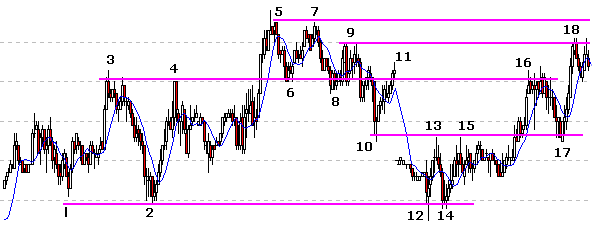
Great post DB,
I like the chart. I think it shows nicely that S/R appear on all timeframes. I'm guessing that it's a 5min intraday chart you posted? I also like the fact that you've replaced a maxim with another maxim -- "if S has been tested twice and price returns there yet again, sellers assume that there's a reason and they prepare to short that return" -- but you have a valid point that all trading rules/assumptions/maxims are broken. It's impossible for a trader to be profitable 100% of the time and therefore that means that sometimes our assumptions as traders are incorrect. But as a trader you have to deal with that and the key is to have a strategy in place for when we are incorrect, i.e. stops. S/R areas need to be monitored to gauge the reaction of the market, you're able to form opinions of the market dependant on those reactions. Once you've formed opinions of the market you're in a position to trade the market.
This is a great thread which brings a great deal of information to the table and reminds me of a snip from the classic book Reminiscences of a Stock Operator where a brokerage firm runner goes to his boss and says that he's got the low down on a certain stock and that the big players are buying. The boss then calls the floor and sells 1000 of said stock. "What?" the runner says. "Did you not hear me right? They're buying." So the boss picks up the phone and says "Sell 1000 more". At this point the runner is getting quite irate. "Boss, they are buying and all you are doing is selling. Do you not trust me?" The Boss then studies the tape and sees that his orders have not budged the market. He then picks up the phone and buys 10000 of the same stock. "You see, boy, if your information was incorrect, my selling 2000 would have made an impact on the tape. It didn't move it one bit so therefore that confirmed to me that someone was absorbing my selling, so your information was correct. Thank you very much." Please forgive me that it's not word for word but I think it demonstrates nicely that the boss identified the market support by selling 2000 lots of the stock in order to gauge the market reaction. He saw that the market absorbed his order easily therefore he knew the big players were buying (supporting) and was in a position to go long.
It's the soaking up of that supply which causes those in the know to get long. The big players will defend their position by absorbing the supply and adding to their position along the way. The market shows a lot of effort (volume) for little result (small price range), which is a tip-off to those looking.
These players are happy for the market to flow between Support and Resistance, but they control the range by buying at/near support and selling at/near resistance. Adding to their position near support and taking a little off near resistance, but they will still remain net long. It's hard for the big players to mark-up the market quickly with the number of contracts/lots they require and getting a good price throughout. It's the controlling of these price ranges (S/R) which allows them to satisfy their objectives (getting long/short at a decent average price).
Cheers, Dan


